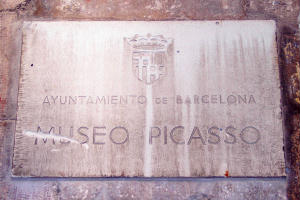The Picassos

The
Museu Picasso, Barcelona
The Museu Picasso in
Barcelona appeared deserted as I admired Science
And Charity.
I suddenly became aware of
an old man beside me, also studying the painting.
‘Picasso was a fine
artist,’ I ventured.
‘Indeed,’ my
companion concurred. ‘His death from scarlet
fever in 1898 was a tragedy.’
‘Picasso died in 1973,’
I corrected.
The stranger was silent for
some moments. ‘Follow me,’ he said.
He led to Carrer De
La Riera De Sant Joan, From The Window Of The
Artist’s Studio and pointed at the random,
shapeless daubs of black and brown paint.
‘Does this look like it was painted by the
same person?’
It was certainly radically
different in style. ‘Surely there was just
one Picasso?’ I queried.
My guide shook his head.
‘After his success at the National Fine Arts
Exhibition in Madrid in 1897 powerful people
recognised Picasso’s future financial
potential. When he died they formed a secret
brotherhood to conceal the death.’
‘How could that be
done?’
The old man beckoned
onwards to Portrait
Of The Writer Ramon Raventós and The
Embrace.
‘These are by a young unknown who closely
resembled Picasso. The Brotherhood found him in
Horta de Sant Joan.’
I looked closely at the
paintings. ‘They aren’t so accomplished.’
‘Sadly, he had little
time to improve before he was struck by lightning
near Madrid in 1901.’
My companion moved to The Madman. ‘This is a self portrait of
his replacement. They discovered him in a Paris
lunatic asylum.’
‘He showed talent,’
I observed.
‘Unfortunately the
voices in his head kept commanding him to buy
blue paint. His apartment was stacked from floor
to ceiling.’
My informant gestured
towards The
Forsaken.
‘And he insisted on painting such miserable,
depressing works with it.’
‘What became of him?’
I enquired.
‘Collapsing crates of
his blue paint crushed him to death in 1905. They
couldn’t clean all the pigment from the body.
He was bright turquoise in his casket.’
‘And his
successor?’
‘An inspired artist,
but rapid onset macular degeneration led to
virtual blindness by 1917. He then developed
Parkinson’s disease.’
We continued past canvasses
depicting misplaced and disconnected features
characteristic of paintings by a blind person who
lacked muscle control.
The old man paused again at
Portrait
Of Jaume Sabarés With Ruff And Hat. ‘He completed this just
before he died in London in 1939.’
‘This one died too?’
‘An inexperienced
helper was pushing his wheelchair across a
railway level crossing…’
‘Four Picassos dead?’
‘The Brotherhood named
it “The Curse of the Picassos”. They
chose to not recruit another.’
‘Who undertook later
works?’
‘Members of the
Brotherhood or their relatives. None had any
artistic talent but, by that time, anything with
“Picasso” written on it was hailed as a
masterpiece and work of genius. They employed an
actor for photographs and public appearances.’
We stopped at The
Pigeons.
‘I particularly like this one,’
continued the old man. ‘It was done by the
five year old granddaughter of one of the
Brotherhood. She meant them to be doves but
couldn’t get the tails right.’
We finally arrived at the
gallery containing the interpretations of the
Velázquez masterpiece, Las
Meninas.
My companion gestured at
the paintings. ‘By now, the Brotherhood had
removed the C, A and O from Picasso and were
taking the other four letters with a vengeance.’
I closely examined the
childlike scrawls and scribblings on several
pieces: (1), (2). It was clear that my guide was
telling the truth. ‘How do you know all this?’
I asked.
I turned around. The old
man had vanished as quickly and silently as he
had appeared.
I left the museum past a
photograph of the Picasso of later years. He bore a remarkable resemblance
to my recent companion and had the same bright
eyes and mischievous smile.
As I glanced back at that
picture, I even believe he winked.
|